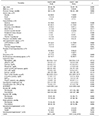Abstract
Figures and Tables
FIG. 1
BP measurements over the course of dialysis treatment according to the CACS group. (A, B) Median systolic and diastolic BPs changed from 146/73 mmHg pre-dialysis to 142/77 mmHg post-dialysis in the CACS <400 group; on the other hand, BPs changed from 157/61 mmHg to 149/67 mmHg in the CACS ≥400 group. Patients with CACS ≥400 had slightly higher systolic BPs and lower diastolic BPs than those with CACS <400 (p for systolic BPs = 0.061, 0.017, 0.227, 0.377, and 0.071; p for diastolic BPs = 0.083, 0.095, 0.066, 0.053, and 0.049). (C) Median pulse pressures over the dialysis treatment were wider in the CACS ≥400 group compared to the CACS <400 group (p=0.010, 0.002, 0.011, 0.011, and 0.002). Pulse pressure at pre-dialysis was 71 (55, 80) mmHg in the CACS <400 group and 81 (76, 106) mmHg in the CACS ≥400 group; Pulse pressure then changed to 68 (55, 76) mmHg and 85 (72, 99) mmHg at post-dialysis in the two groups, respectively. BP: blood pressure, CACS: coronary artery calcium score. *p<0.05.

FIG. 2
CACS according to the presence of intradialytic hypotension or hypertension. Median CACS was compared between patients with and without intradialytic BP abnormalities. CACS of patients with intradialytic hypotension (Nadir100 or Fall30) was 237 (62, 1416) or 237 (37, 1314), respectively, and these were similar to those without the complication (Nadir100: CACS 295 [80, 1318]; p=1.000; Fall30: CACS 314 [119, 1348]; p=0.661). In addition, CACS was 350 (37, 1458) in patients with intradialytic hypertension and 194 (82, 1316) in those without intradialytic hypertension (p=0.626). Intradialytic hypotension is defined as a minimum intradialytic systolic BP <100 mmHg (Nadir100) or pre-dialytic systolic BP − minimum intradialytic systolic BP ≥30 mmHg (Fall30). Intradialytic hypertension is defined as an increase in systolic BP ≥10 mmHg. BP: blood pressure, CACS: coronary artery calcium score.

FIG. 3
Correlation of CACS with intradialytic systolic BP fall or nadir systolic BP. (A, B) Correlation was analyzed to find whether CACS influences the degree of systolic BP fall or the lowest systolic BP during the dialysis treatment. Linear regression analyses showed that CACS was not associated with either intradialytic systolic BP fall or nadir systolic BP (r=0.2 and 0.1; p=0.277 and 0.415). Intradialytic systolic BP fall refers to pre-dialytic systolic BP − minimum intradialytic systolic BP. Nadir systolic BP refers to minimum intradialytic systolic BP. BP: blood pressure, CACS: coronary artery calcium score.

TABLE 1
Baseline characteristics according to CACS

Continuous variables are expressed as median (25th, 75th percentile), and categorical variables are expressed as numbers (percentage). ACE: angiotensin-converting enzyme, ARB: angiotensin II receptor blocker, BP: blood pressure, CACS: coronary artery calcium score, ECW/TBW: the ratio of extracellular water to total body water.
*Intradialytic hypotension is defined as a minimum intradialytic systolic BP <100 mmHg (Nadir100) or pre-dialytic systolic BP minimum intradialytic systolic BP ≥30 mmHg (Fall30).
†Intradialytic hypertension is defined as an increase in systolic BP ≥10 mmHg during hemodialysis.
TABLE 2
Impact of CACS and intradialytic BP abnormalities on cardiovascular events

CACS: coronary artery calcium score, ECW/TBW: the ratio of extracellular water to total body water.
*Variables with a p<0.10 in univariate analyses are included in multivariate models.
†Intradialytic hypotension is defined as a minimum intradialytic systolic BP <100 mmHg (Nadir100) or pre-dialytic systolic BP minimum intradialytic systolic BP ≥30 mmHg (Fall30).
‡Intradialytic hypertension is defined as an increase in systolic BP ≥10 mmHg.
TABLE 3
Impact of CACS and intradialytic BP abnormalities on all-cause mortality

CACS: coronary artery calcium score, ECW/TBW: the ratio of extracellular water to total body water.
*Variables with a p<0.10 in univariate analyses are included in multivariate models.
†Intradialytic hypotension is defined as a minimum intradialytic systolic BP <100 mmHg (Nadir100) or pre-dialytic systolic BP minimum intradialytic systolic BP ≥30 mmHg (Fall30).
‡Intradialytic hypertension is defined as an increase in systolic BP ≥10 mmHg.




 PDF
PDF ePub
ePub Citation
Citation Print
Print


 XML Download
XML Download